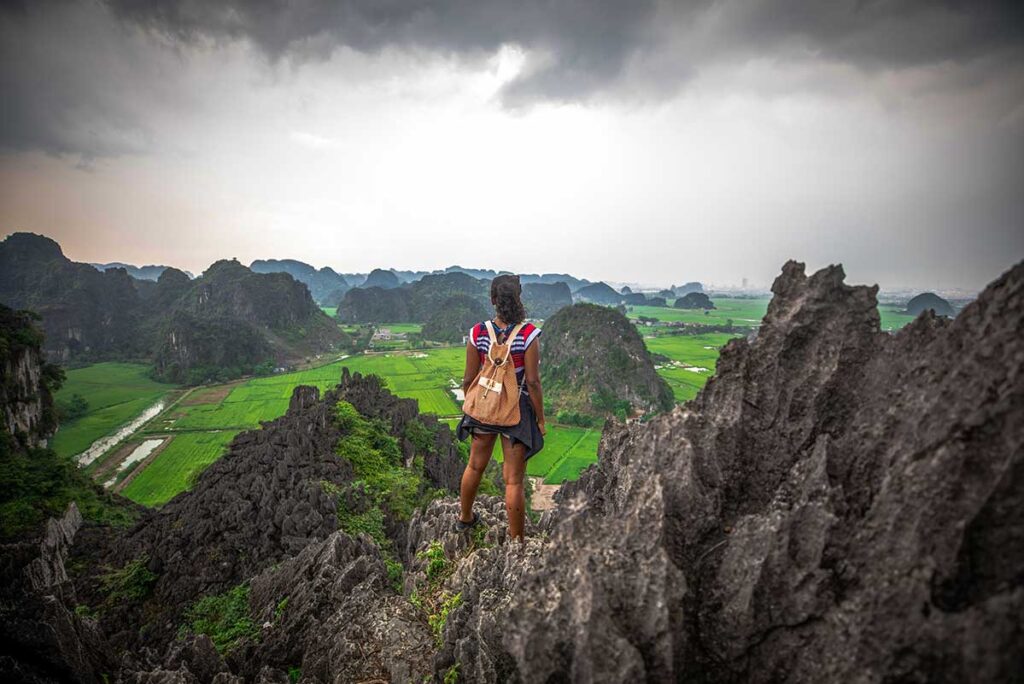What is Phuoc Binh National Park?
Phuoc Binh National Park lies in Bac Ai District, northwest of Phan Rang in Ninh Thuan Province, bordering Lam Dong and the Bidoup–Nui Ba highlands. Covering an area of roughly 19,800 to 25,000 hectares, it protects a transitional zone where the Central Highlands meet the South Central Coast.
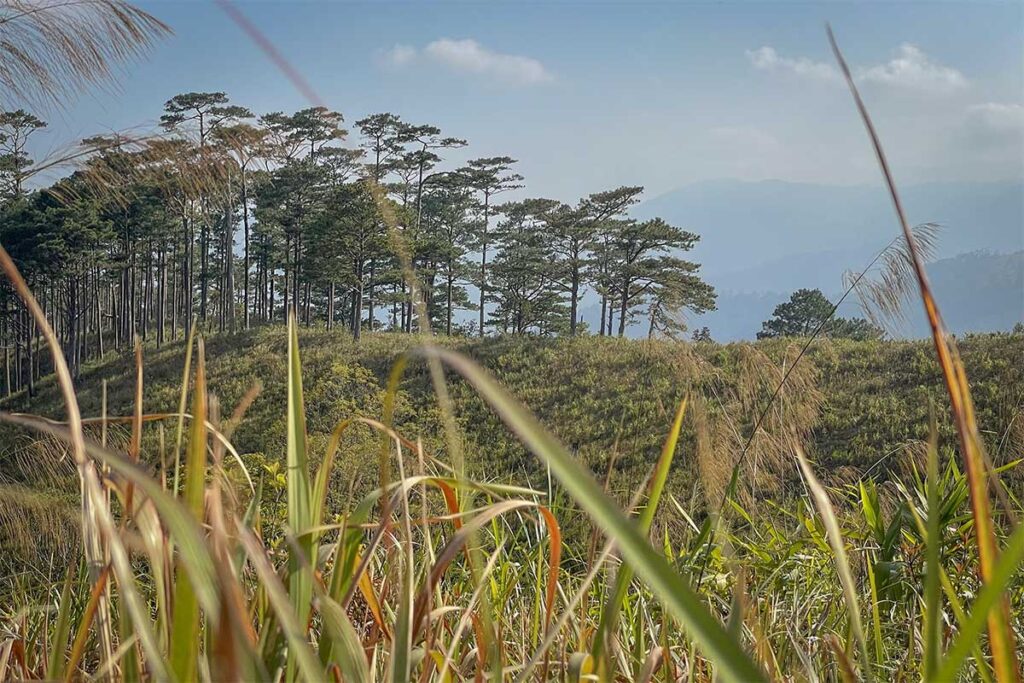
The park is valued for its evergreen forests, river systems, and diverse ecosystems, home to more than a thousand plant species and hundreds of animal species, including several listed in Vietnam’s and the world’s Red Books. Three main rivers – Gia Nhong, Suoi Da May, and the Cai – originate here, making the park a crucial watershed area.
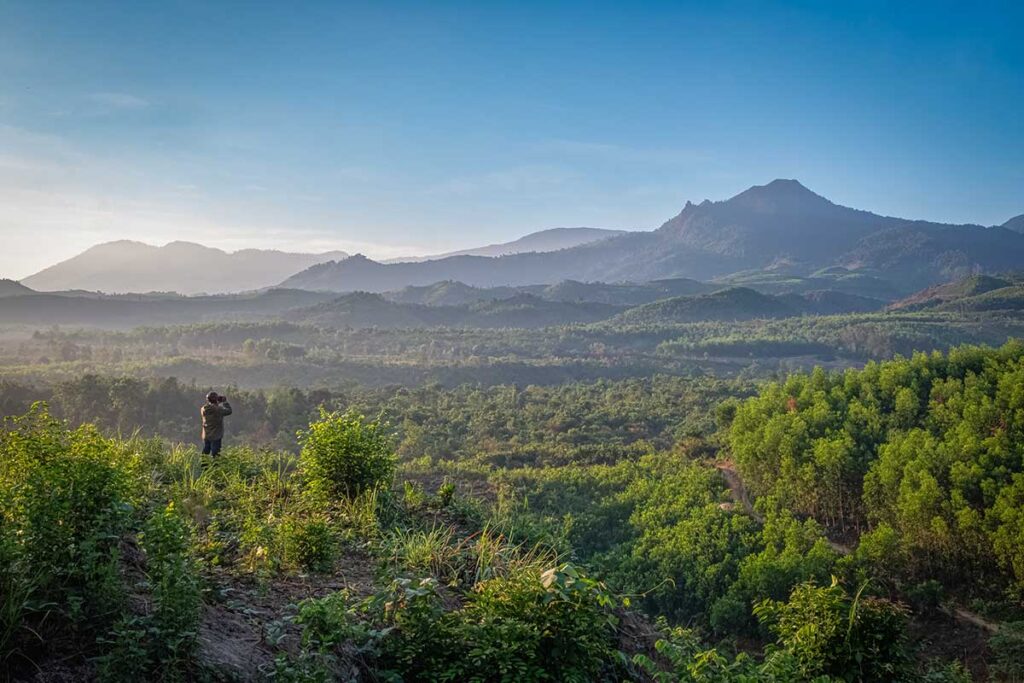
Beyond nature, Phuoc Binh is also the traditional homeland of the Raglai and Churu ethnic groups, whose stilt houses, music, and farming traditions are closely tied to the forest. Thanks to this combination of ecological and cultural importance, the park is often called the “green lung” of Ninh Thuan, safeguarding both biodiversity and the livelihoods of local communities.
Best time to visit
Phuoc Binh has a climate that feels very different from the hot, dry lowlands of Ninh Thuan. Sitting between 600 and 1,200 meters above sea level, it combines a highland coolness with the milder influence of the coastal plain, making the air fresher and temperatures more comfortable year-round.
The park has two main seasons. The dry season (December to March) is the most straightforward for trekking, with clear skies and easier trails. The rainy season (April to November) brings heavier showers, but also makes the landscape greener and the waterfalls more dramatic—though paths can get muddy and slippery.
If you want the best overall experience, January to October offers a good balance between comfortable trekking and lively waterfalls. For those interested in local culture, March–April is when the Raglai people celebrate the new rice festival, a rare opportunity to see traditional music, rituals, and dances tied to the agricultural calendar.
How to get there
By road
The easiest gateway is Phan Rang–Thap Cham city, about 60–70 km from the park. From there, it’s a 1.5–2 hour drive up into Bac Ai District.
- Bus + taxi/motorbike: Long-distance buses from Ho Chi Minh City, Da Lat, or Nha Trang stop in Phan Rang. From the city, you can hire a taxi or rent a motorbike for the final stretch into the park.
- Private car/self-drive: A flexible option if you want to combine Phuoc Binh with other stops (e.g. Nui Chua or coastal attractions). Roads from Phan Rang are paved and generally in fair condition, but winding and narrow once you enter the mountains.
- Motorbike: Popular with adventurous travelers. The coastal road from Ho Chi Minh City via Phan Thiet, Mui Ne, and Phan Rang is one of Vietnam’s most scenic rides before turning inland to Bac Ai. Expect long travel times and plenty of sun exposure.

By train
Trains along the north–south line stop at Thap Cham Station near Phan Rang. From there, you’ll need local transport (taxi or motorbike rental) to continue into the park. This option is slower but can be combined with an overnight train journey from Ho Chi Minh City or Nha Trang.
By plane
The nearest airports are Cam Ranh (Nha Trang), about 100 km away, and Lien Khuong (Da Lat), roughly 120 km. Both require a road transfer afterward, usually via Phan Rang or Ninh Son.
Travel time and Road notes
- From Ho Chi Minh City: 6–7 hours by car or bus to Phan Rang, plus 1.5–2 hours onward to the park.
- From Da Lat: Around 3–4 hours by car, crossing mountain passes.
- From Nha Trang: About 3–4 hours by car via Cam Ranh and Phan Rang.
The final approach into Phuoc Binh follows winding mountain roads that are paved but can be narrow and uneven in sections. Travel is possible year-round, but rainy season may bring slippery surfaces and occasional washouts, so extra caution is advised if you drive yourself.
Things to See & Do in Phuoc Binh National Park
1. Trekking & Nature trails
The main way to explore Phuoc Binh is on foot. The most accessible route is the Gia Nhong – Da Ban Waterfall loop, which takes you through forest, across small streams, and past village fields. It’s not a long trek—usually a half-day walk—but trails can be uneven and slippery in the rainy season.


Longer, guided hikes are possible for those who want to reach deeper waterfalls or camp overnight.
2. Waterfalls & Streams
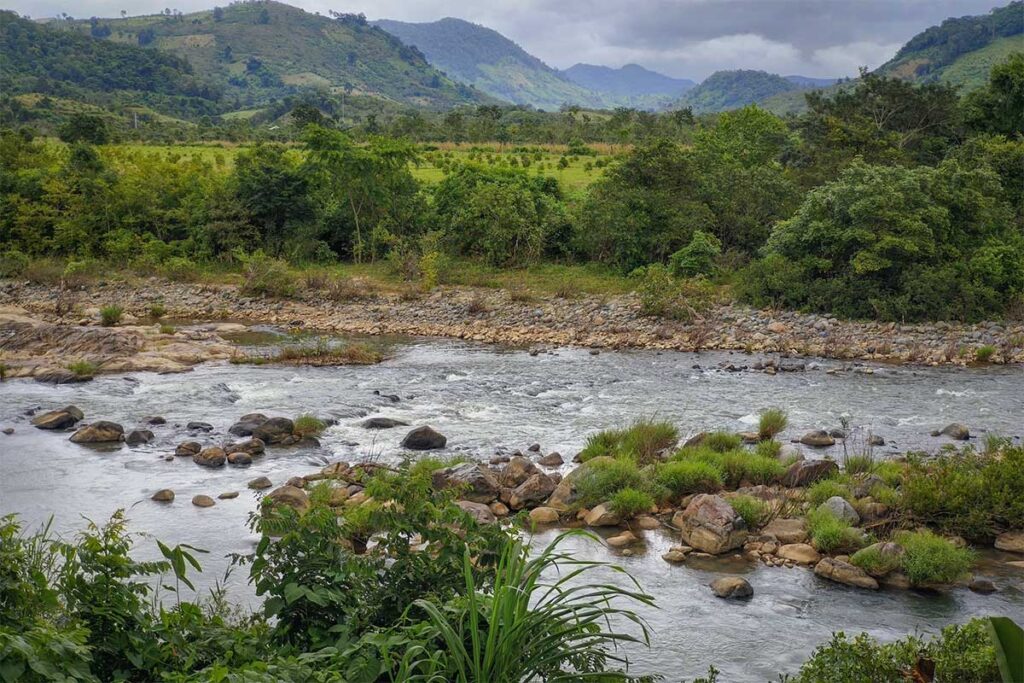
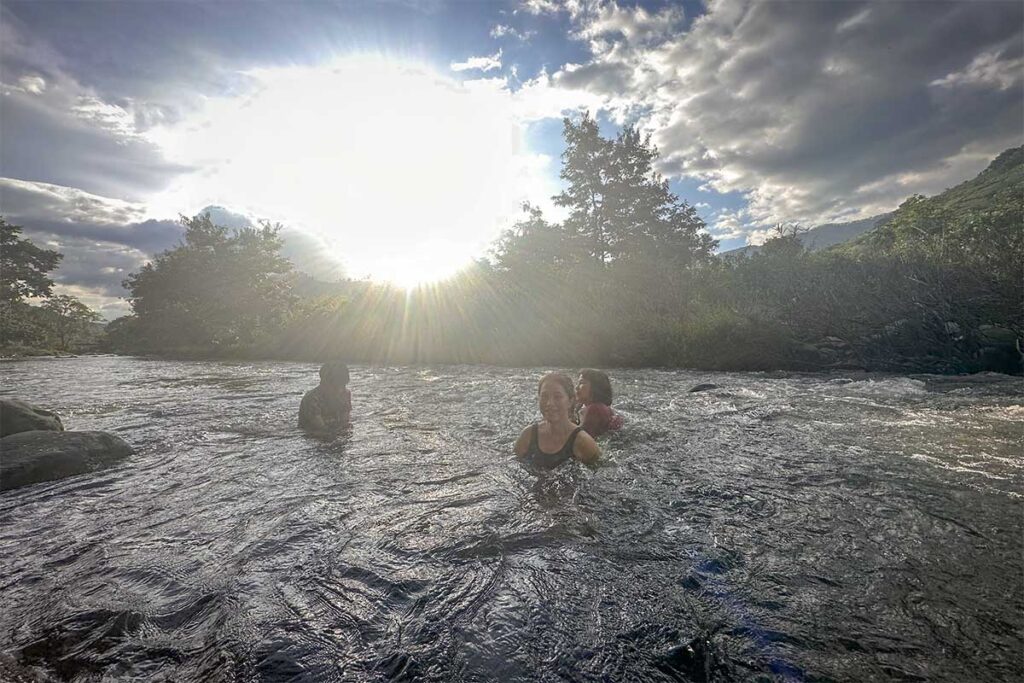
- Da Nhong Stream: A calm place to rest, dip your feet, and enjoy the sound of flowing water.
- Da Ban Waterfall: A short trek from the park entrance, this wide cascade flows year-round and is a popular spot for bathing and photos.
- Chapor (Ma Lam) Waterfall: More remote, reached by a forest path of about 45 minutes. It’s smaller than Central Highlands giants, but the surrounding rock formations and old trees make it atmospheric.
- Other cascades: Smaller falls such as Ba Tang, Da Den, and Hon Chan are scattered across the park, often requiring local knowledge or a guide to reach.
3. Forest & Biodiversity
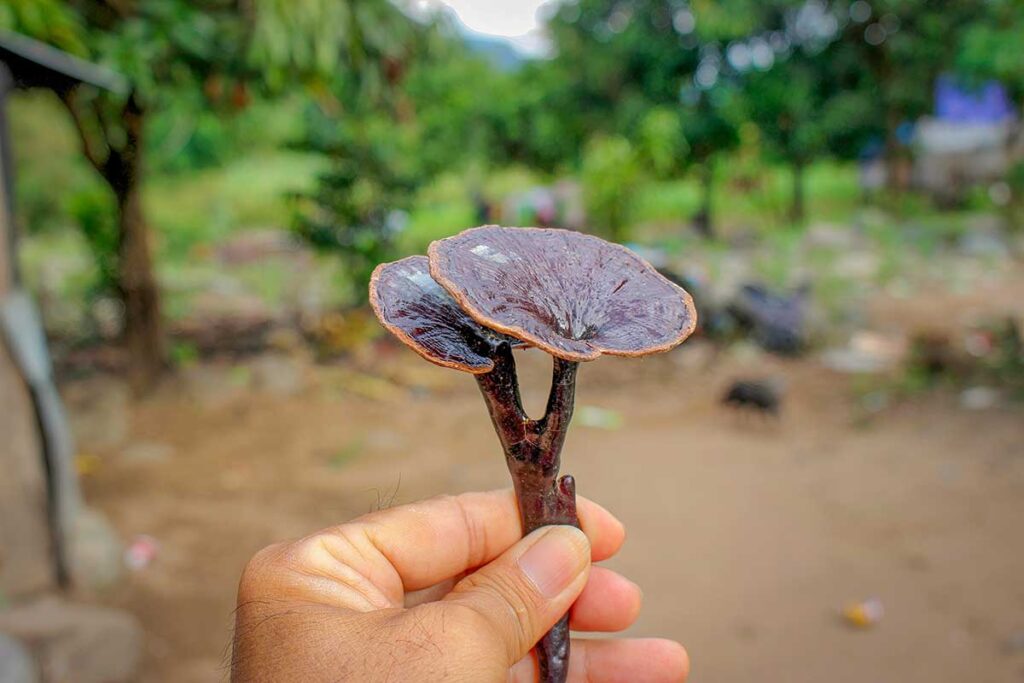
The park protects a transitional ecosystem between the coast and the highlands. You’ll find old-growth trees like Kơ Nia and evergreen conifers such as pine and bách xanh, along with orchids and medicinal plants.
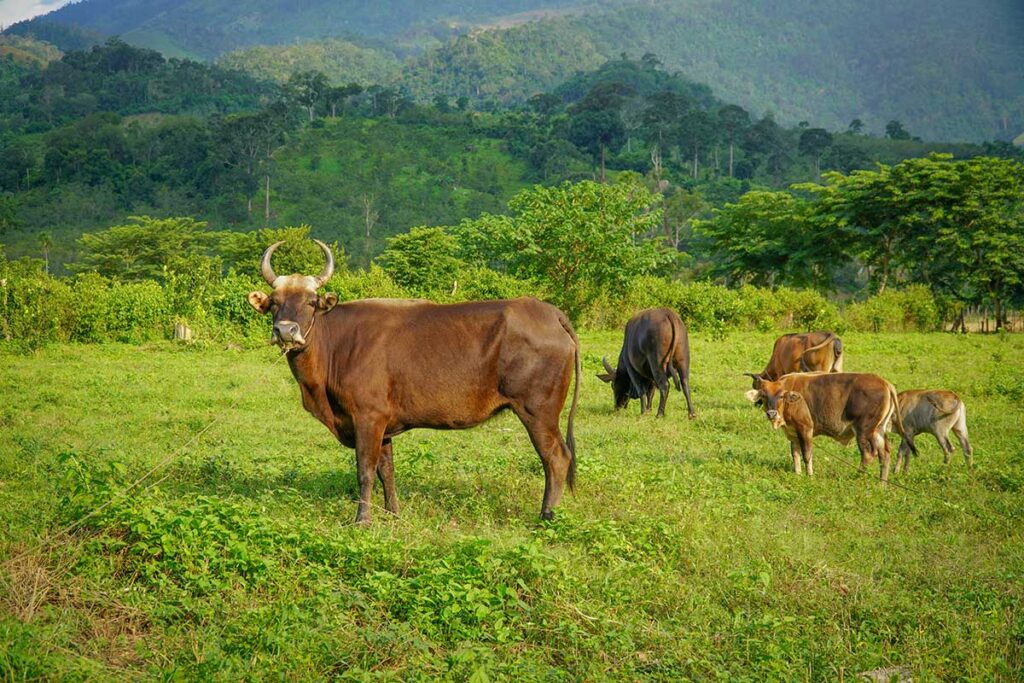
Wildlife includes langurs, gibbons, gaurs, and a wide variety of birds. However, like in most Vietnamese parks, sightings of large mammals are very rare; the appeal here is more about the forest atmosphere and the chance of spotting smaller wildlife.
4. Local culture & Villages
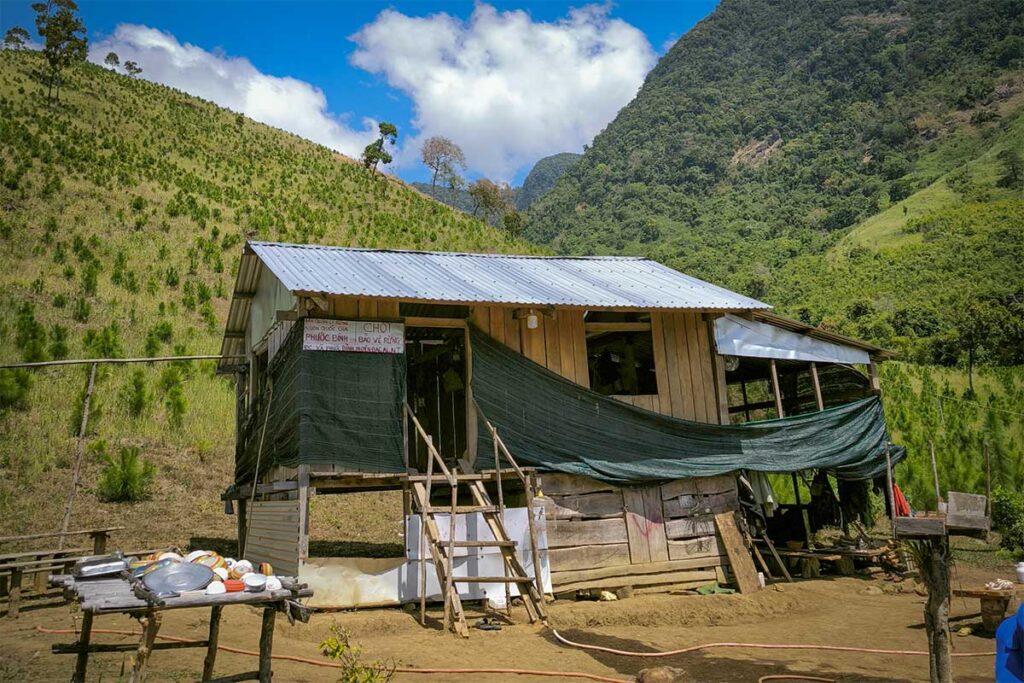
Phuoc Binh is home to the Raglai and Churu communities, whose villages lie around the park. Visitors may see stilt houses, small farms, and cultural traditions such as the Chapi string instrument or stone percussion music. If your timing is right, you might witness a local festival, such as the new rice celebration in spring, though these are not staged for tourists. Respectful travelers can sometimes join homestays to experience daily life firsthand.
5. Camping & Adventure activities
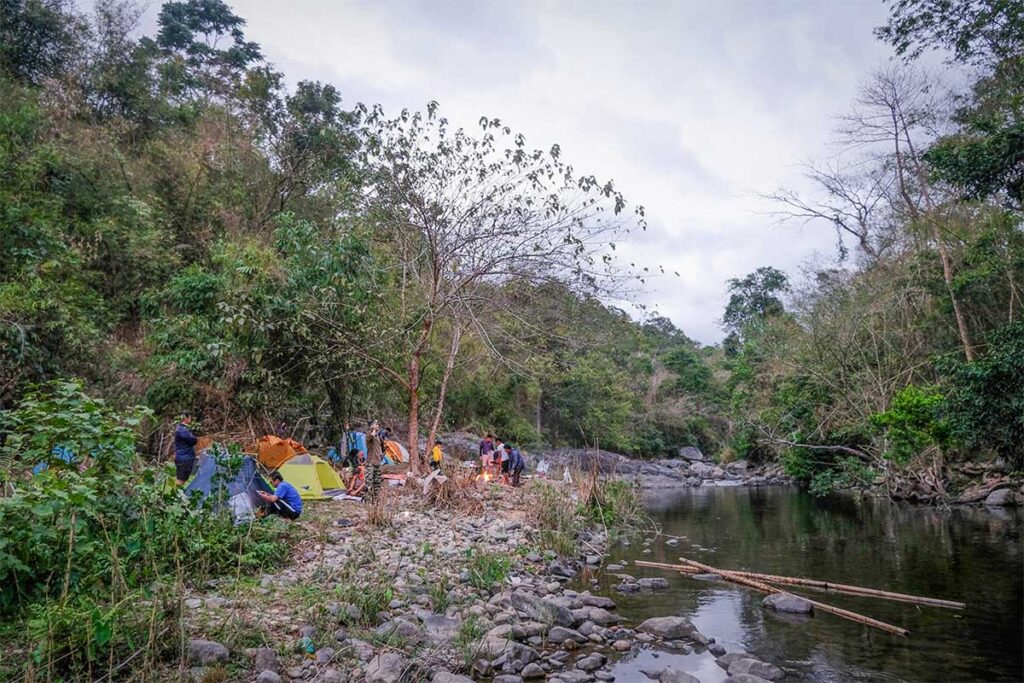
For a closer connection to nature, you can camp by streams like Gia Nhong or stay at designated camping spots. Adventure activities include stand-up paddleboarding (SUP), bamboo rafting, or fishing in the rivers. A more challenging option is to hike Bac Ray 2 Mountain, where early risers are sometimes rewarded with a cloud sea view at sunrise. Facilities are limited, so most activities need to be arranged with a guide or local contact in advance.
Accommodation options
Homestays in Raglai Villages
Staying in a Raglai homestay gives you a closer look at local life. Expect simple stilt houses, shared sleeping areas, and basic facilities. Meals are usually cooked by the family and often include local specialties. This is a good option if you’re interested in cultural immersion and don’t mind modest comfort. The downside is that facilities can be very basic, with limited privacy and no modern amenities.
Camping
Phuoc Binh has an official camping area near Gia Nhong Stream where tents can be set up under tall trees, close to the water. It’s a pleasant way to spend the night if you’re traveling with a guide or organized group. Independent camping is possible, but you’ll need to check with the park authorities for permission. Bring your own gear, as equipment rental is limited. Nights can get cool, and insects are common, so preparation is essential.
Nearby hotels & Guesthouses
If you prefer more comfort, the practical choice is to stay in Phan Rang city, about two hours away by road. Phan Rang offers a wider range of hotels, from budget guesthouses to mid-range resorts by the beach. This setup works well if you want to do a day trip into the park while keeping a comfortable base in the city.
Food & Local specialties
Food in Phuoc Binh reflects its forest setting and ethnic traditions. Most meals are simple, hearty, and made with whatever is grown or gathered locally.

- Forest-based dishes: Common staples include com lam (rice cooked in bamboo tubes), grilled chicken, black pork, wild bamboo shoots, and freshwater fish from the streams. These are often cooked over open fire, giving a smoky flavor.
- Raglai food traditions: If you stay in a homestay, you may be offered traditional recipes such as lap meat (marinated and grilled), canh thinh (fermented soup), or smoked chicken. Homemade forest wines are also a local specialty, sometimes drunk communally.
- Fruits: The surrounding highlands are fertile, so seasonal fruits like grapefruit, durian, or bananas often make their way into meals or as snacks.
There are no restaurants inside the park itself. Expect meals prepared by homestays or guides, which can be very enjoyable if you like rustic, local food. For more variety or comfort dining, you’ll need to eat in Phan Rang city before or after your visit.
Tours & Trekking programs
Organized tours are the easiest way to explore Phuoc Binh, since trails are not always well-marked and local contacts are needed for homestays or camping. Programs are usually arranged through the park office, local guides, or tour companies in Phan Rang.
- 1-day trekking: A good choice if you’re short on time. Typically includes a forest walk along the Gia Nhong stream, a visit to Da Ban waterfall, and lunch with a local family. Moderate hiking, but still involves uneven terrain.
- 2 days / 1 night trekking + camping: Combines a full day of hiking with an overnight stay in the forest or at a riverside campsite. Expect campfire cooking, swimming in streams, and a closer feel for the wilderness.
- 2 days / 1 night with ethnic village stay: Instead of camping, you overnight in a Raglai village. This option focuses more on cultural exchange, with traditional food, local stories, and sometimes music or rituals, depending on timing.
Why take a guided tour?
- Safety: Trails are not always obvious, and rivers can rise quickly in rainy months. A guide helps avoid getting lost or injured.
- Cultural interpretation: Local guides can introduce you to Raglai and Churu communities in a respectful way, which you would not manage on your own.
- Logistics: Meals, homestays, and camping spots usually need to be arranged in advance. A guide or tour operator takes care of these details.
Independent exploration is possible in theory, but for most foreign travelers, joining a guided program makes the experience smoother and more rewarding.
Practical travel tips
- Entrance tickets: Buy at the gate (around 20,000 VND per person). Keep the ticket handy if you plan to enter different sections.
- Guides: For anything beyond a short walk, a local guide is usually required. This is both for safety and to coordinate with villages or campsites.
- What to pack: Good walking shoes with grip, insect repellent, sunscreen, and rain protection. A small first-aid kit and a flashlight are also useful if camping.
- Road & trail conditions: Roads to the park are paved but narrow and winding. Trails can be muddy and slippery in the rainy season, so a trekking pole can help.
- Respect local culture: Dress modestly in villages and always ask before taking photos of people. Some rituals and ceremonies are private.
- Environmental responsibility: Do not litter, light campfires only where permitted, and avoid picking plants or disturbing wildlife.
- Connectivity: Expect weak or no mobile signal once you’re deeper into the forest. Let someone know your plans before heading in.
Is Phuoc Binh National Park worth visiting?
Phuoc Binh is a rewarding destination if you enjoy trekking, waterfalls, and authentic encounters with Raglai or Churu communities. The scenery is fresh and green, the climate cooler than the lowlands, and the chance to camp or stay in a simple homestay makes it feel more adventurous than many other parks in Vietnam.
That said, it’s not for everyone. Facilities are very basic, trails are not well-marked, and information in English is scarce. Don’t expect easy sightseeing, well-developed infrastructure, or guaranteed wildlife spotting—this is more about atmosphere than ticking off highlights. Foreign visitors are still rare here, which makes the experience unique but also less straightforward to organize compared with places like Bidoup–Nui Ba near Da Lat.
If you only have time for one park in Ninh Thuan, Nui Chua National Park is easier to reach from the coast and more popular with casual visitors. If you’re looking for highland trekking and cooler forests, Bidoup–Nui Ba has better-established trails and guiding services. Phuoc Binh sits somewhere in between—quiet, off-the-beaten-path, and best for travelers who don’t mind the lack of comfort in exchange for a genuine, less-touristed experience.


